Mornings shouldn’t mean choosing between feeling energized and eating something that actually tastes good. If you’re watching your carb intake but refuse to settle for boring breakfasts, you’re in the right place.
The right low-carb breakfast keeps your blood sugar steady, crushes mid-morning cravings, and gives you the mental clarity to tackle your day. No crash at 10 AM. No reaching for the office snack drawer.
I’ve tested these five recipes myself, and they deliver on both flavor and function. Whether you need something grab-and-go or have time for a proper sit-down breakfast, there’s an option here that’ll work for your routine.
Why Low-Carb Breakfasts Actually Work
Your body processes carbs quickly, which sounds convenient until you’re hungry again an hour later. Low-carb breakfasts flip this script by prioritizing protein and healthy fats.
When you start your day with protein-rich foods, you’re giving your body sustained fuel. Your blood sugar stays balanced instead of spiking and crashing. This means better focus, more stable energy, and you’re not thinking about food every 90 minutes.
The science backs this up too. Studies show that high-protein breakfasts improve appetite control throughout the day and can help with weight management when that’s your goal.
But here’s what matters most: these breakfasts need to taste good, or you won’t stick with them. That’s exactly what these five recipes deliver.
1. Crispy Low-Carb Keto Muesli – Homemade
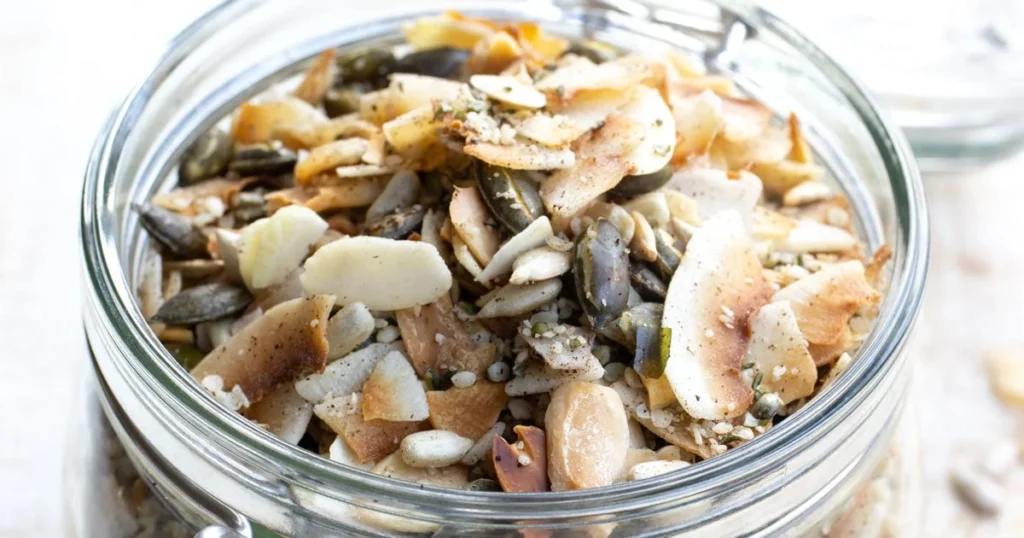
Store-bought granola is basically candy in a healthy-looking package. This homemade version gives you that satisfying crunch without the carb overload.
The base combines nuts, seeds, and unsweetened coconut flakes. You’ll get almonds, pecans, pumpkin seeds, and sunflower seeds working together. Instead of oats (which pack about 27g of carbs per half cup), you’re using ingredients that clock in under 5g net carbs per serving.
What makes it work: The combination of healthy fats from nuts and fiber from seeds keeps you full for hours. Baking everything with a touch of cinnamon and sugar-free sweetener creates those crispy clusters you’re craving.
Mix it with unsweetened almond milk or full-fat Greek yogurt. Add some fresh berries if your carb budget allows it. You can make a big batch on Sunday and have breakfast sorted for the week.
The texture rivals any conventional granola. The difference? You won’t be hungry before lunch.
2. Low-Carb Avocado with Egg – Stuffed & Baked
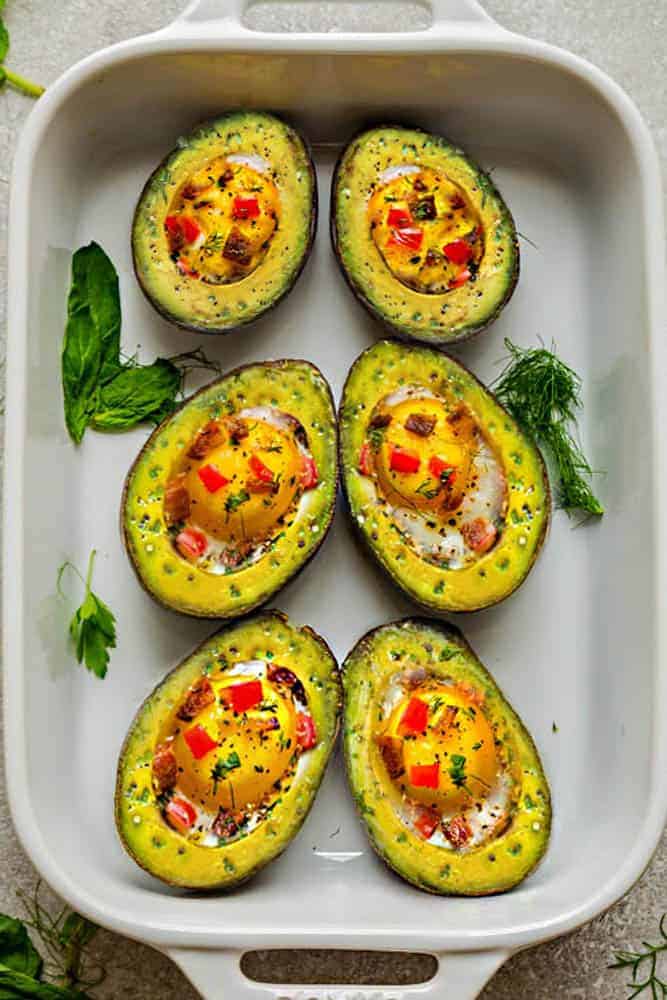
This one looks fancy enough for brunch guests but takes about 20 minutes total. You’re basically creating an edible bowl that’s packed with nutrients.
Cut an avocado in half, scoop out just enough to make room for an egg, then crack one into each half. Season with salt, pepper, and whatever else you’re feeling (I like red pepper flakes). Bake at 425°F for about 15 minutes until the egg white sets but the yolk stays runny.
The nutritional breakdown is impressive: One serving gives you about 20g of protein, healthy monounsaturated fats from the avocado, and only 6g of net carbs. You’re also getting potassium, vitamin E, and B vitamins.
The creamy avocado with runny egg yolk creates this rich, satisfying combination that feels indulgent. Add some crumbled bacon or smoked salmon on top if you want to level it up.
This breakfast keeps your energy steady because the fat content slows digestion. You’re not getting that carb rush and subsequent crash.
3. Low-Carb Egg Muffins – Mini Omelettes from the Oven
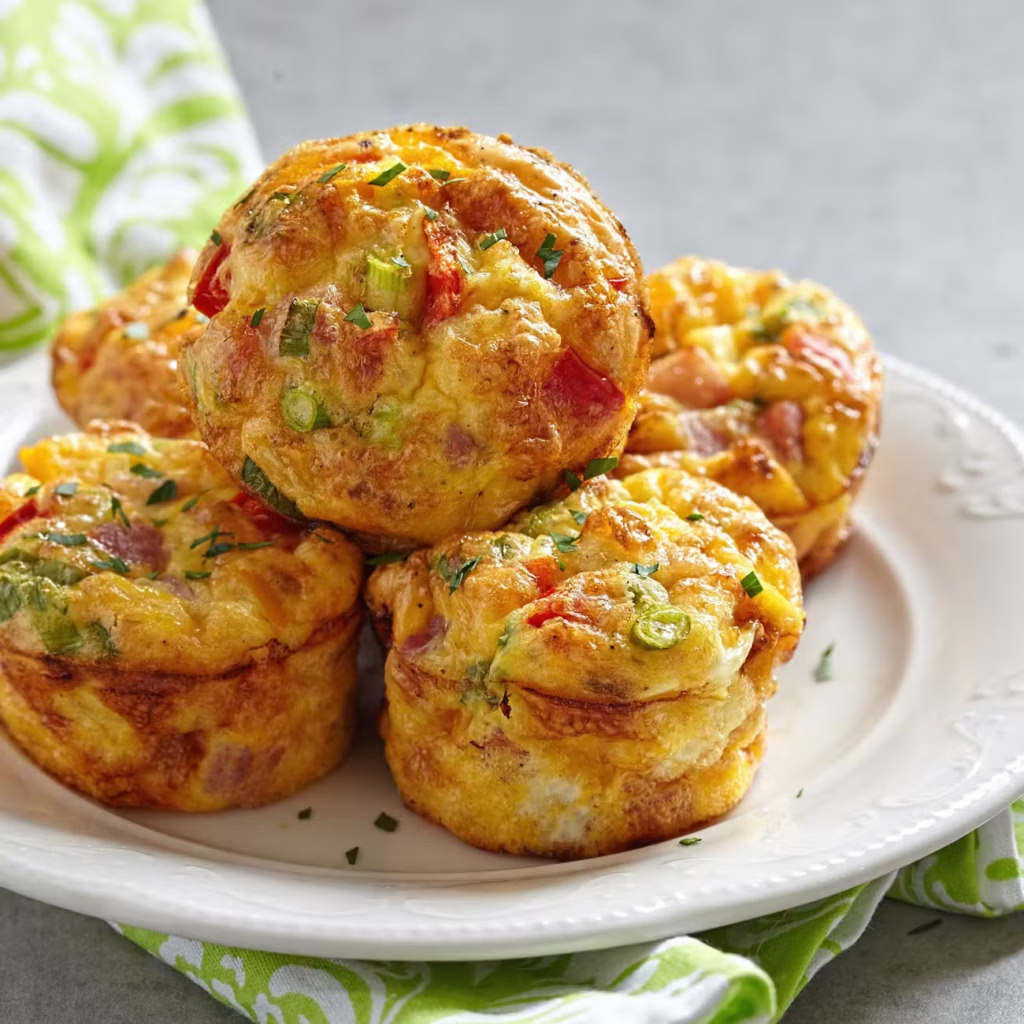
If weekday mornings feel chaotic, these egg muffins are your answer. Make a dozen on Sunday, grab two on your way out the door each morning.
Beat eggs with a splash of cream, then add your favorite omelet ingredients. I rotate between spinach and feta, bacon and cheddar, or mushroom and swiss. Pour into a greased muffin tin and bake at 350°F for 20-25 minutes.
Why they’re practical: Each muffin has roughly 5g of protein and under 1g of carbs. They reheat perfectly in 30 seconds. You can customize each one differently if you’re feeding picky eaters.
The texture stays fluffy even after refrigeration, which isn’t true for regular scrambled eggs. The individual portions make it easy to track your intake if that matters to you.
Pack them for work lunches too. They’re good cold, room temperature, or heated up. That’s versatility you can’t get from a bowl of cereal.
4. Fluffy Low-Carb Keto Pancakes – Only 5 Ingredients
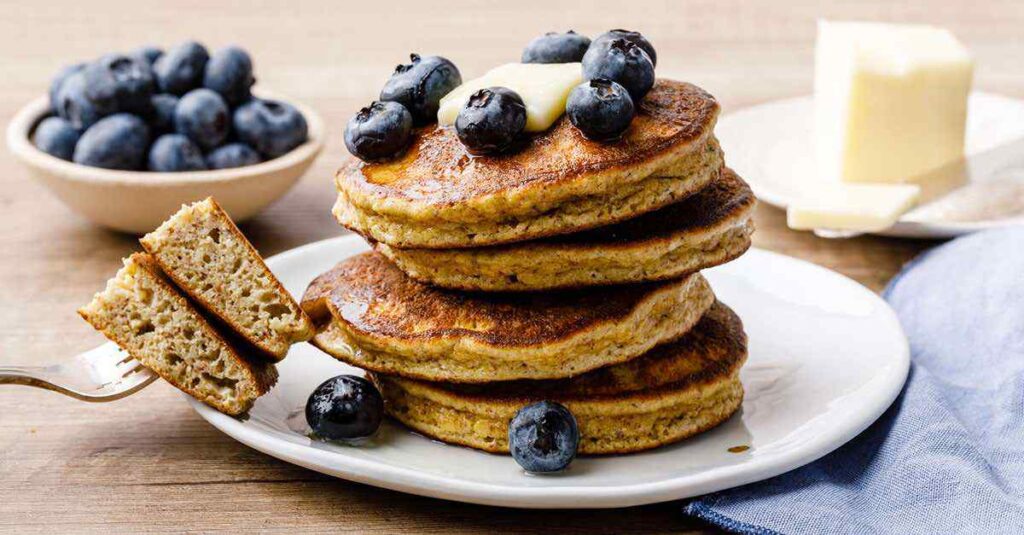
Pancakes on a low-carb diet sound impossible until you try this recipe. The secret? Cream cheese and almond flour working together to create that familiar texture.
You need cream cheese, eggs, almond flour, baking powder, and vanilla extract. Blend the cream cheese and eggs until smooth, add the dry ingredients, then cook them like regular pancakes on a griddle or non-stick pan.
The result surprises people: These aren’t dense or eggy. They’re legitimately fluffy with a slight tang from the cream cheese that works perfectly with sugar-free syrup or fresh berries.
Each pancake has about 3g net carbs compared to 15-20g in traditional pancakes. You can eat a satisfying stack without derailing your goals.
The batter keeps in the fridge for a few days, so you can make it ahead and have fresh pancakes in minutes. They also freeze well if you want to batch cook.
Top them with butter, sugar-free maple syrup, or a dollop of whipped cream. Add some crispy bacon on the side and you’ve got a weekend breakfast that doesn’t feel like you’re missing out on anything.
5. Low-Carb Keto Waffles Without Sugar
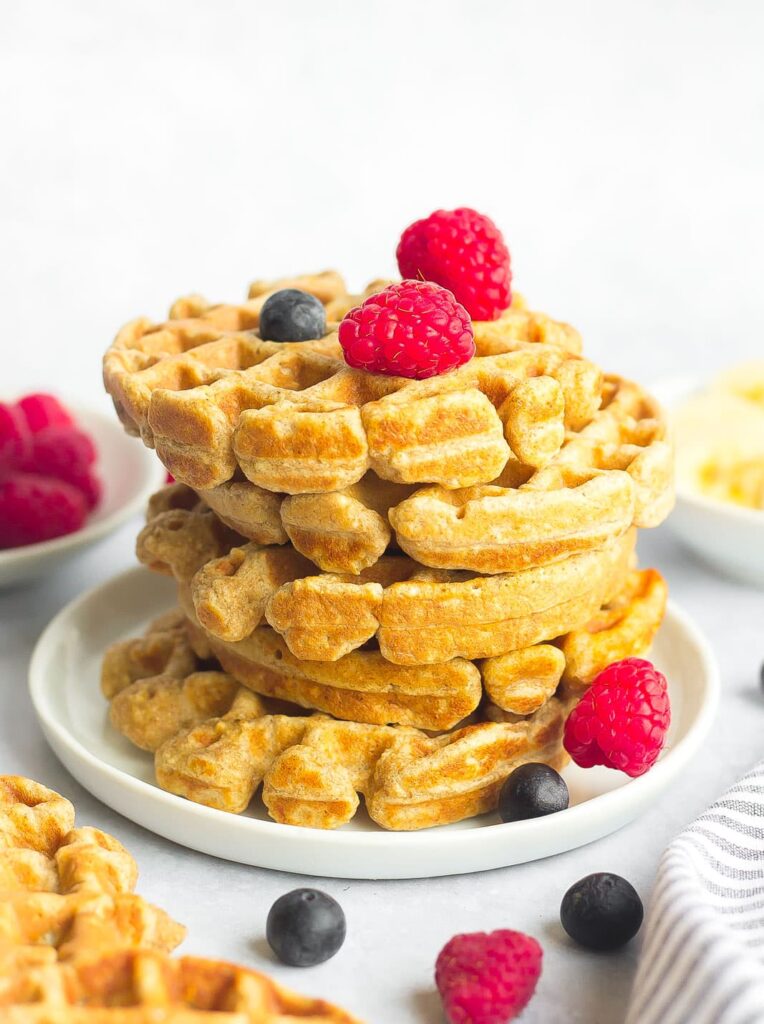
Waffles have that crispy exterior and fluffy interior that pancakes can’t quite match. This low-carb version nails both while keeping carbs under 4g per waffle.
The base uses almond flour and coconut flour together. This combination gives you structure without the grittiness that sometimes comes with single-flour recipes. Add eggs, melted butter, baking powder, and a sugar-free sweetener.
Texture matters here: A hot waffle iron is essential. The high heat creates those crispy edges while keeping the inside tender. Don’t skip preheating your waffle maker.
These waffles don’t get soggy when you add toppings, which makes them perfect for building a real breakfast plate. Try them with whipped cream and strawberries, or go savory with fried eggs and bacon on top.
They freeze beautifully too. Pop them in the toaster on busy mornings and you’ve got a hot breakfast in under two minutes. That’s faster than most drive-through options and infinitely better for your energy levels.
The recipe makes about 6-8 waffles depending on your waffle iron size. I usually double the batch because they disappear quickly.
Comparison Table: Breakfast Ideas at a Glance
This table gives you a quick reference when you’re planning your week. Pick based on your schedule, mood, or what ingredients you already have in the kitchen.
| Breakfast Idea | Advantage | Ideal for… |
|---|---|---|
| Crispy Low-Carb Keto Muesli | Make once, eat all week. Crunchy texture satisfies cereal cravings without the carb spike. | Busy mornings when you need grab-and-go convenience. People who miss the crunch of traditional breakfast cereals. |
| Low-Carb Avocado with Egg | Looks impressive, tastes indulgent. Packed with healthy fats that keep you full for hours. | Weekend brunches or when you have 20 minutes to spare. Anyone craving a restaurant-quality breakfast at home. |
| Low-Carb Egg Muffins | Ultimate meal prep champion. Customizable to everyone’s taste. Reheats perfectly in 30 seconds. | Hectic weekday mornings. Families with different flavor preferences. People who eat breakfast on the commute. |
| Fluffy Low-Carb Keto Pancakes | Only 5 ingredients. Feels like a treat but keeps carbs low. Freezes well for future breakfasts. | Weekend mornings when you want something special. Parents feeding kids who won’t eat “diet food.” Anyone missing traditional pancakes. |
| Low-Carb Keto Waffles | Crispy exterior stays crunchy even with toppings. Works for sweet or savory preparations. | Lazy Sunday mornings. People who prefer texture variety. Anyone who wants a versatile breakfast base. |
Making Low-Carb Breakfasts Work in Real Life
Having recipes is one thing. Actually using them consistently is another. Here’s what makes the difference between good intentions and actual results.
Prep on your schedule: You don’t need to meal prep everything. But having one or two options ready makes busy mornings manageable. The egg muffins and muesli store well for days.
Stock your pantry smart: Keep almond flour, coconut flour, eggs, and cream cheese on hand. These ingredients show up in most low-carb breakfast recipes. When you’ve got the basics, you can make something good even when groceries run low.
Mix up your routine: Eating the same thing every day gets old fast, even if it’s healthy. Rotate through these five options to keep things interesting.
Start with whichever recipe sounds most appealing. Get comfortable making it, then add another to your rotation. You don’t need to overhaul your entire morning routine in one day.
Common Low-Carb Breakfast Mistakes to Avoid
Not all low-carb breakfasts are created equal. Some common approaches actually make mornings harder instead of easier.
Skipping fat is a mistake. Low-carb doesn’t mean low-calorie. If you’re not eating enough fat with your protein, you’ll be hungry again quickly. That avocado, the cream cheese in the pancakes, the nuts in the muesli—they’re not optional.
Artificial sweeteners in excess can backfire. A little in your pancakes or waffles is fine. Overdoing it might trigger cravings for more sweet foods later. Use them strategically.
Relying only on eggs gets boring. Yes, eggs are convenient and low-carb. But if you’re forcing down plain scrambled eggs every morning, you’ll burn out. These five recipes give you variety that actually tastes good.
Not eating enough protein early. Aim for at least 20-30g of protein at breakfast. This amount supports muscle maintenance and keeps hunger in check. All five recipes here hit this target when portioned properly.
Frequently Asked Questions
Can I meal prep these low-carb breakfasts?
Yes, all five options work for meal prep with different storage times. The egg muffins and muesli last 5-7 days in the fridge. Pancakes and waffles freeze for up to 3 months. The baked avocado with egg is best made fresh, but you can prep your avocados and have eggs ready to crack into them each morning.
How many carbs should I aim for at breakfast?
Most people following a low-carb diet target 20-50g of net carbs daily. For breakfast, keeping it under 10-15g net carbs works well. This leaves room for carbs from vegetables and other whole foods throughout your day. All five recipes here fall within this range.
Will low-carb breakfasts help with weight loss?
They can support weight loss as part of an overall low-carb approach, but they’re not magic. The benefit comes from better appetite control and stable blood sugar. When you’re not constantly hungry, you naturally eat less throughout the day. Combined with regular activity and adequate sleep, low-carb breakfasts become one useful tool in managing your weight.
What if I don’t like eggs?
The muesli is your best bet as it’s completely egg-free. You can also try chia seed pudding made with unsweetened almond milk, or full-fat Greek yogurt with nuts and seeds. Smoked salmon with cream cheese on cucumber slices works too. Low-carb doesn’t mean eggs at every meal.
Are these recipes suitable for kids?
Absolutely. Kids often love the pancakes and waffles especially. The egg muffins work well for picky eaters since you can customize them to individual preferences. Just remember that growing children need more carbohydrates than adults following strict low-carb diets, so adjust portions accordingly and include plenty of vegetables and fruits throughout their day.
How long do these breakfasts keep me full?
Most people report feeling satisfied for 4-5 hours after these meals. The combination of protein and fat digests slowly, which prevents the blood sugar rollercoaster that causes hunger. Individual results vary based on your activity level and metabolism, but you should easily make it to lunch without snacking.
Your Low-Carb Morning Starts Now
You don’t need to choose between eating well and enjoying your breakfast. These five recipes prove you can have both.
Start with one that fits your schedule. Make it a few times until it feels natural. Then add another to your rotation. Before you know it, you’ll have a collection of go-to breakfasts that support your goals without feeling like work.
The real test isn’t how you feel after one good breakfast. It’s whether you’re still making these recipes a month from now. Keep it simple, focus on what tastes good, and pay attention to how your body responds.
Your mornings are about to get a lot better.
